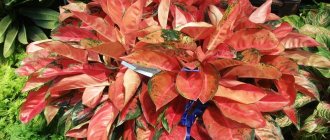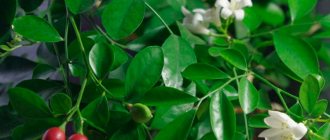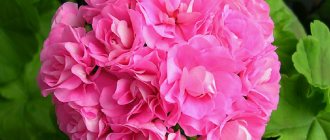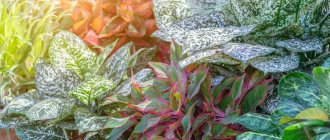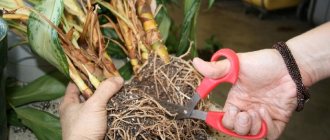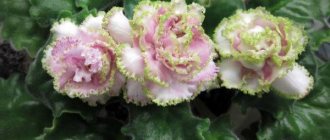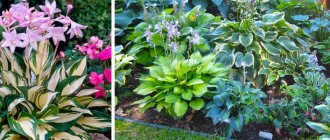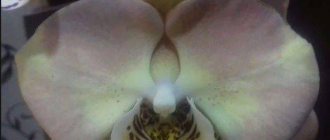Photo of aglaonema Aglaonema (Aglaonema) is an ornamental evergreen plant from the Araceae family. Southeast Asia is considered its homeland. It is found naturally in the Philippines, New Guinea, and India. The height of the bush ranges from 25 to 75 cm. The trunk is not noticeable. The flower attracts attention with its leathery green leaves, which have an oblong shape and pointed ends. They clearly show a central light stripe and small patterns in the form of spots and stripes.
Aglaonema grows slowly; the foliage is replenished with 5–6 leaves per year. It blooms rarely, producing an inflorescence - an ear, wrapped in a pale blanket. At home it lives up to 3 years, then it loses its decorative properties and needs updating.
| Growth up to 6 leaves per year. |
| It blooms very rarely. In autumn. |
| The plant is easy to grow. |
| Perennial. But after 3-4 years the leaves are no longer so variegated. It is better to grow a new plant every 3-4 years. |
Beneficial features
It humidifies the air in the room. Reduces the level of toxic substances released by new furniture and gas stoves. Some species disinfect the air, clearing it of anaerobic bacteria. During a period of intensive growth, a flower releases air ions that cause a charge of vigor and increase resistance to stress.
Reviews
A relative of Dieffenbachia, the plant Aglaonema, came to me several years ago. <…> Over the course of several years, the plant grew longer and the color became less variegated, so I grew a new one from a tip cutting, which was not difficult to do. I like this indoor flower because it does not require special care, effectively purifies indoor air, and reduces the content of harmful substances that enter the apartment.
tamarav https://spasibovsem.ru/responses/rodstvennitsa-diffenbahii.html
I really like Aglaonemas for their unpretentiousness and variety of colors. For about two years I tried to root several different varieties. Unfortunately, they didn't want to grow. She fed, sprayed, tried to find the most suitable place. Everything was useless. I decided to tackle the root system. For six months I watered it with Ribav and Zircon (to form a root system). The result was not long in coming.
irulchik https://myfl.ru/category/nazvanie-rasteniya/aglaonema
My aglaonemas appeared not so long ago, but the red color is completely preserved. I think that in good lighting conditions it will not disappear. Shrinking of leaves, disappearance of variegation - these are similar to signs of insufficient lighting. In my opinion, red aglaonema, like its less colorful relatives, is a very unpretentious plant. It has a lot of advantages - it tolerates overdrying, low humidity, heat and at the same time does not dry out the tips of the leaves and retains an attractive appearance. In general, I am a fan of this plant, like all others with beautiful leaves.
Vanda https://flo.com.ua/forum/viewtopic.php?t=17400
Features of growing at home. Briefly
Despite its tropical origin, aglaonema grows well at home if you follow the basic rules for growing it:
| Temperature | In winter, without watering, it can withstand up to + 10 -15°C, in summer + 24°C. |
| Air humidity | Increased; Spray frequently in summer, less often in winter, but keep the flower pot in a tray with moistened expanded clay. |
| Lighting | Scattered; slight shading. |
| Watering | Settled lukewarm water; In summer the soil should be moist, in winter it should be watered rarely, about once every 10 days. |
| Priming | Air-permeable, loose, moisture-retaining - ready-made soil for bulbous plants or prepared yourself from garden soil, peat, perlite (1: 2: 1), for young bushes - from leaf soil, turf soil, perlite, peat (2: 1: 1: 1. |
| Feeding and fertilizer | Once every 14 days, alternating mineral fertilizers and organic matter in liquid form. |
| Transfer | A week after purchase, transfer it to a small low pot with a drainage hole; Young bushes are replanted every spring, adult plants - once every 4 years. |
The plant is unpretentious and easy to care for, but there are some peculiarities in growing aglaonema. All parts of the flower contain toxic substances, oxalic acid, which cause skin burns and irritation of mucous membranes. The juice and berries that appear after the plant blooms cause severe allergies. Therefore, you need to work with the plant very carefully, wearing gloves. Make sure that children and animals do not touch the bush.
Caring for aglaonema at home. Details
The aglaonema flower develops correctly in indoor conditions and feels good if its needs for light, warmth, nutrition and moisture are met.
Landing
The high decorative properties of the plant largely depend on proper planting.
The quality of planting material (cuttings, seeds, fragment of a bush) is important. If you choose the seed planting option, use only fresh seeds collected from ripe scarlet berries. Planting is carried out in spring and summer. A fertile, loose, breathable acidic substrate will provide the plant with good nutrition and improve its appearance. Planting aglaonema involves choosing the right place. The flower feels comfortable on a window facing any side except the south: bright sunlight can cause burns to the foliage.
Bloom
Aglaonema rarely blooms at home.
The beauty of the plant lies in its variegated emerald leaves. Aglaonema flowering is an unattractive phenomenon. From February to November, inconspicuous inflorescences in the form of greenish-yellow cobs, wrapped in a pale blanket, form in the axils of the upper leaves. There can be 1 - 3 pieces. Depending on the variety, the cobs look like a thick short club or a thin long cylinder. Sometimes gardeners sacrifice inflorescences and cut them off for the sake of new leaves. If you don’t do this, you can wait for the fruits to appear - scarlet (less often white) berries with a single grain inside.
Temperature
To preserve the decorative appearance of the flower, it is important to strictly observe the temperature regime. Aglaonema is a heat-loving plant. Drafts and sudden changes in temperature can destroy it. Although there are varieties that can withstand cold temperatures down to + 10°C, the optimal temperature for a flower is considered to be between 15 – 25°C in summer and 15 – 18°C in winter.
If you do not water in winter, the plant can tolerate lower temperatures.
Spraying
The tropics are characterized by high air humidity. To make indoor aglaonema feel comfortable, you need to spray the plant twice every 14 days in the summer, take a warm shower, or wipe the leaves with a damp cloth more often. Just don’t allow moisture to accumulate in the rosette of leaves: this can lead to the death of the plant.
In winter, spraying is carried out less frequently, but the flower is placed in a tray with moistened expanded clay or pebbles . During the heating season, the flower is kept away from radiators, air humidifiers are used, or an open container of water is placed nearby.
Lighting
Lighting is important for plant growth. Aglaonema is genetically configured to receive a lot of light, but it should not be bright and scorching, but diffused.
The scorching summer sun can burn the flower, so windows facing south are dangerous for it. It is best to place green-leaved bushes in partial shade. Variegated types of aglaonema, on the contrary, love bright sunlight: under its influence the leaves become more beautiful. But a little shading is also beneficial for these species. In winter, additional lighting is installed for them.
Watering
The plant is moisture-loving, but stagnation of water is detrimental to it. Watering of aglaonema is carried out in spring and summer, when the top layer of soil dries out.
In winter and when aglaonema is kept in a cool room, this is done less often - about once every 10 days. For irrigation, take clean water, settled in the room.
Pot size
There are no small details in the maintenance of the plant. For proper development, even the size of the pot in which the flower is planted is important. A low pot of small volume is preferable. The tightness will stimulate the formation of new leaves and strengthen the root system of the bush.
Priming
Breathable, moisture-retaining soil for aglaonema is very important. The flower grows well in acidic, loose soil. These characteristics correspond to the ready-made soil mixture for bulbous plants. You can make the soil yourself by taking garden soil, peat, perlite (1: 2: 1), and put 2 times more leafy soil for young bushes.
You can add charcoal to the mixture. For mature plants, the amount of turf soil can be increased.
Feeding and fertilizer
Feeding and fertilizing with mineral and organic substances is an important component of flower care.
Aglaonema is fertilized once every 2 weeks with liquid formulations for decorative foliage plants, containing not only the main elements, potassium, phosphorus and nitrogen, but also microelements that prevent alkalization of the soil. To preserve the decorative appearance of the foliage, foliar feeding is carried out: the leaves are sprayed with diluted liquid fertilizer. It is best to do this after watering in cloudy weather, so as not to accidentally burn the plant. All feeding is carried out from the beginning of March to the beginning of October.
You cannot fertilize in winter, because the plant is resting at this time.
Transfer
Aglaonema is transplanted for the first time a week after purchase. When it adapts a little to home conditions, it is transferred from a temporary pot to a permanent container. Young bushes are replanted once a year, adults - once every 4 years. Replanting aglaonema is necessary when the roots completely entwine the earthen ball. It is always produced in the spring.
A new pot is chosen 20 - 30 mm larger than the previous one. It must have drainage holes and a place to pour a thick layer of drainage, which is necessary so that the water in the pot does not stagnate. The soil is carefully selected, taking into account that it loves acidic and loose soil. The soil mixture should include turf soil (an adult bush can put more of it), peat, leaf soil, charcoal and perlite (sand).
Rest period
Like most plants, the dormant period of aglaonema falls in winter . At this time, they reduce the amount of watering and stop stimulating growth with fertilizers and fertilizing.
Trimming
When aglaonema grows, its trunk becomes exposed. This suggests that the flower needs pruning , with the help of which its rejuvenation is carried out. Cut off the top of the plant with a sharp knife, and dust the cut areas with charcoal powder. The stump is left in the pot.
They continue to take care of it and wait for renewal buds to appear. And the top is rooted in water in which activated carbon is pre-dissolved to avoid souring. Sometimes the top is immediately planted in moist soil. Cover with polyethylene and keep at a temperature of +25°C until rooting.
Homemade aglaonema does not require special care; if properly maintained, it will grow healthy and become a real decoration of the interior.
Botanical description
This is a herbaceous evergreen plant from the Araceae family. The stem is erect and fleshy, branching at the base. In young specimens the stem is practically invisible, but with age it grows a little.
Leathery leaves with a dense crust can grow on both short and long petioles. They have smooth edges with a clearly visible central vein. The color of the sheet plates depends on the type.
During the flowering period, small flowers bloom, collected in an inflorescence spadix of 1-3 pieces. It is framed by a greenish blanket. Inflorescences can be of different thickness and length.
In place of faded inflorescences, juicy orange berry fruits with 1 seed develop.
Aglaonema is poisonous, or rather, its milky juice. It is released when damaged, for example, when a sheet breaks. When replanting this indoor flower, use rubber gloves. By the way, the berries of this flower are also poisonous. The juice causes swelling and soreness in the mucous membranes of the mouth and throat, and upon contact with the eyes, conjunctivitis and changes in the cornea. Skin irritations also appear.
Reproduction of aglaonema
If the flower trunk begins to branch or become bare, the plant is ready to reproduce. Reproduction is possible in different ways.
Reproduction by dividing the bush
The easiest method.
- Take the aglaonema out of the pot and inspect the root system.
- Fragments with a developed root system are separated.
- They are planted in separate containers.
- Water, cover with film and leave at a temperature of + 23°C for several days for the plant to take root.
- It is periodically watered and sprayed.
Propagation of aglaonema by cuttings
Conducted when the trunk is exposed.
- The apical shoot up to 10 cm long is cut off, the cut is sprinkled with coal powder and dried.
- Then they are immersed 5 cm in wet sand.
- Cover with film and keep for a month at + 25°C until the bush gives roots.
- Water and ventilate periodically.
Growing aglaonema from seeds
Perhaps when the aglaonema self-pollinates. The plant produces scarlet fruits. When they ripen on the bush, the seeds must be removed from the berries, washed and planted in a mixture of peat and sand, taken in equal parts. Pour, cover with film and leave at + 25°C. The first shoots appear quickly. When 2–3 leaves appear, the bushes are planted in separate pots. After 3 years you will get strong plants.
All propagation methods are accessible and simple, but it is important to know that when propagated by seeds, aglaonema loses its varietal characteristics.
Bloom
The flowering period begins in summer and lasts for 7-14 days. Experienced gardeners recommend removing inflorescences. This is due to the fact that flowering will take a lot of strength and energy from the plant, which can lead to its disease.
How does aglaonema bloom:
Diseases and pests
If you follow basic care rules and create comfortable conditions, aglaonema will grow strong, and many diseases and pests will bypass it. But sometimes difficulties arise when growing a plant:
- the stem is rotting - excess moisture (re-root the top);
- gray spots on aglaonema leaves – fungal damage (fungicides are used);
- leaves curl and turn black - at low temperatures (move to warm);
- the leaves have become pale - lack of nutrients (feed) or little light (move to a brighter place);
- dry spots on the leaves - excess sun (shade);
- grows slowly - a natural process, a slow-growing plant;
- does not grow - lack of light (move to a bright place); watering with cold or hard water (use warm, settled water; to soften, add 0.2 g of citric acid per 10 liters of water); spoiled leaves take away the flower’s strength (clean the bush of them in time) ;
- brown tips of leaves – low humidity (spray, place an open container of water nearby);
- dark spots on the leaves - hypothermia or watering with hard cold water (put in a warm place, water with warm, settled water, adding 0.2 g of citric acid per 10 liters of water);
- the lower leaves turn yellow - a natural physiological process (you can renew the flower by rooting the top);
- droplets on the tips of the leaves - release of excess moisture from waterlogging, temperature changes and air humidity;
- yellow or white spots – sunburn (shade);
- dry edges of leaves, their deformation - lack of moisture and humidity (water well and ventilate without creating a draft);
- marsh-colored spots on the leaves - not enough light (put in a brighter place).
If aglaonema grows weak, it can be attacked by pests: aphids, mealybugs, thrips, whiteflies, spider mites.
Types of Aglaonema domestica
There are about 50 species of aglaonema known to grow in nature. Some of them are grown at home. Depending on the height of the plant, species are divided into 3 groups.
Low growing aglaonemas
Height up to 0.25 m; leaves are creeping or drooping. The most popular 3 varieties:
Aglaonema rotundum
Dark green, heart-shaped leaves with bright pink stripes running along the veins along the entire length of the leaf. The flower is a pink spadix surrounded by a pink and white blanket.
Aglaonema costatum
The trunk branches at the base. Oval green leaves with light spots and stripes. Leaf length is up to 20 cm, width is half that. The flower is a white spadix covered with a green blanket. The smallest aglaonema.
Aglaonema Brevispathum
The trunk is located underground. Narrow green leaves of an elongated shape. There is a vertical white stripe in the center. Produces few leaves. The flower is a spadix covered with a white blanket.
Medium-sized varieties
Bushes up to 50 cm high. The trunk is straight. The leaves are long – up to 30 cm.
Aglaonema Maria
Bush up to 60 cm high. The length of green leaves covered with white spots is 20 cm. The white cob is wrapped in a white blanket. It can grow under artificial light without losing its decorative effect.
Silver Queen
Silvery blue leaves with green streaks. Leaf length – from 15 – 30 cm. Bush height – up to 0.4 m. The white cob is covered with a white blanket only on one side. Loves a lot of light.
Aglaonema Treubii
Green leaves with a silver pattern reach 17 cm. The white cob is wrapped in a snow-white blanket. The most unpretentious type of domestic aglaonema.
Tall aglaonemas
Popular varieties obtained from shade-tolerant species.
Aglaonema Silver Bay
The bush branches from the roots. The trunk is slowly exposed. The height of an adult bush can reach 100 cm. Pointed leaves are up to 30 cm long. In the center they are pale green, along the edges there are dark stripes and spots. The underside is dark green. In an adult bush, the leaves darken. Resistant to cold.
Aglaonema pictum Freedman (Gabriel, Cecilia)
Large, wide leaves with wavy curves along the edges. In the center of the leaf there are light spots, along the edges and closer to the center there are dark green specks. Bush height – up to 150 cm.
Aglaonema Stripes (Aglaonema Stripes)
Oval wide leaves with pointed ends grow up to 35 cm. Dark green stripes alternate with light ones. Connecting at the tip, they form a small light spot.
An exotic ornamental plant, the beauty of which lies not in the original bright flowers characteristic of exotics, but in its unusual leaves. The color of the foliage surprises with the play of green shades with light stripes and spots. Bizarrely located on the leaf plate, they create a special variegated pattern that distinguishes it from other plants. A guest from the tropical forest is a worthy decoration of a modern interior.
